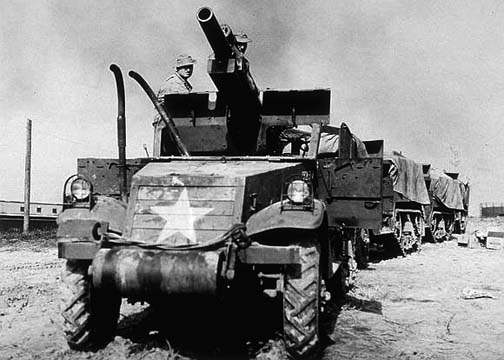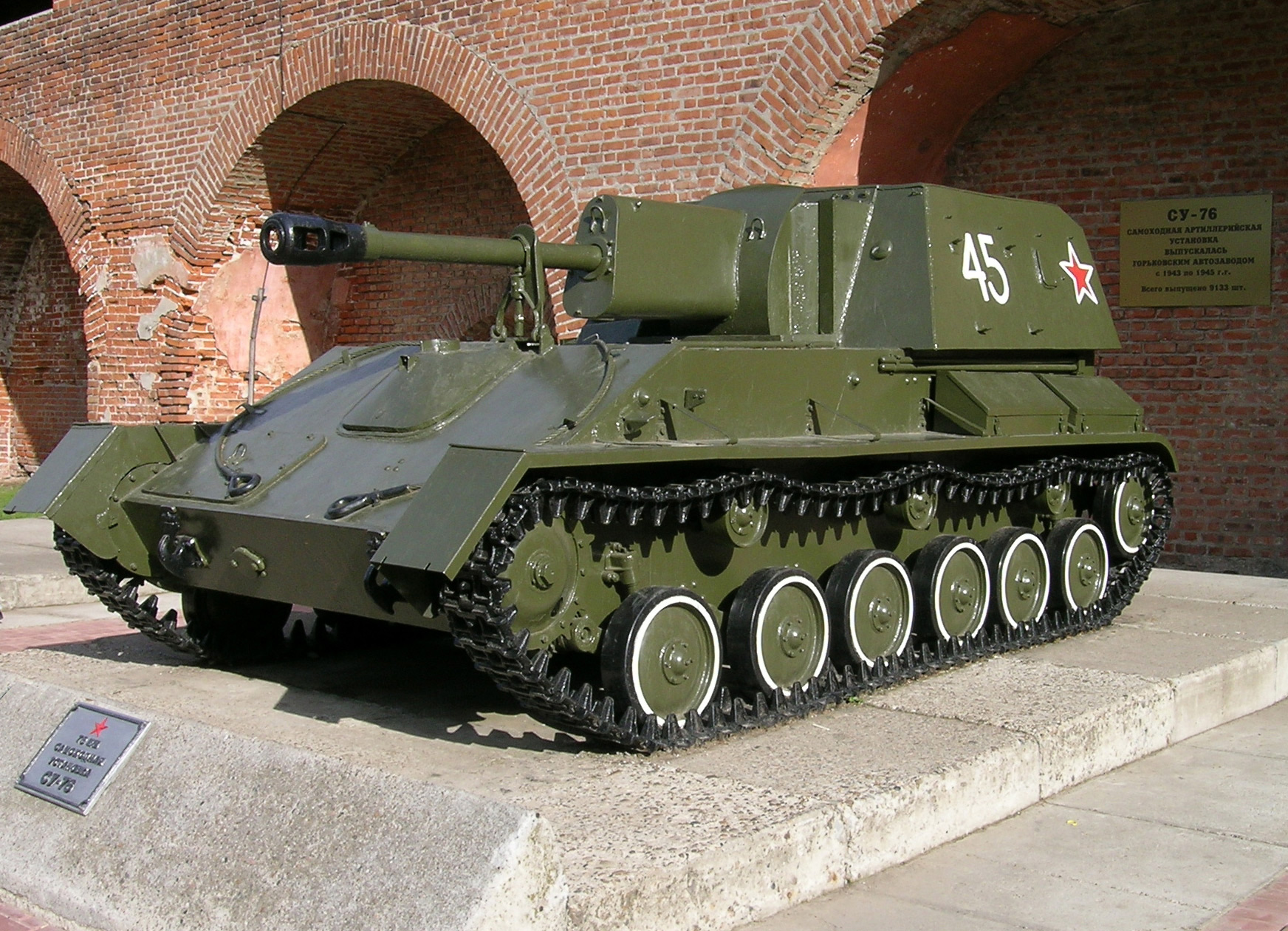|
T30 Howitzer Motor Carriage
The T30 Howitzer Motor Carriage (HMC) was a United States Army self-propelled gun used in World War II. Its design was based on requirements for an assault gun issued by the Armored Force in 1941 and it was built as an interim solution until a fully tracked design was complete. Produced by the White Motor Company, the vehicle was simply a 75 mm Pack Howitzer M1 mounted on a modified M3 Half-track. It was first used in combat in the North African Campaign in November 1942. It later served in Italy and France, and possibly in the Pacific. Some were later leased to French forces and the type was used as late as the First Indochina War in the 1950s. Specifications Based on the M3 Half-track, the T30's specifications were similar to its parent vehicle. It was 20 ft 7 in (6.28 m) long, 7 ft 3.5 in (2.22 m) wide,Ness (2002), p. 207. 8 ft 3 in (2.51 m) and high, and weighed 10.3 short tons (9.3 t).Bishop (1998), p. 81. Th ... [...More Info...] [...Related Items...] OR: [Wikipedia] [Google] [Baidu] |
French Fourth Republic
The French Fourth Republic (french: Quatrième république française) was the Republicanism, republican government of France from 27 October 1946 to 4 October 1958, governed by the fourth republican constitution. It was in many ways a revival of the French Third Republic, Third Republic that was in place from 1870 during the Franco-Prussian War to 1940 during World War II, and suffered many of the same problems. France adopted the constitution of the Fourth Republic on 13 October 1946. Despite the political dysfunction, the Fourth Republic saw an era of great economic growth in France and the rebuilding of the nation's social institutions and Manufacturing, industry after World War II, with assistance from the United States provided through the Marshall Plan. It also saw the beginning of the rapprochement with former longtime enemy West Germany, Germany, which in turn led to Franco-German co-operation and eventually to the development of the European Union. Some attempts were al ... [...More Info...] [...Related Items...] OR: [Wikipedia] [Google] [Baidu] |
Allied Invasion Of Sicily
The Allied invasion of Sicily, also known as Operation Husky, was a major campaign of World War II in which the Allied forces invaded the island of Sicily in July 1943 and took it from the Axis powers ( Fascist Italy and Nazi Germany). It began with a large amphibious and airborne operation, followed by a six-week land campaign, and initiated the Italian campaign. To divert some of the Axis forces to other areas, the Allies engaged in several deception operations, the most famous and successful of which was Operation Mincemeat. Husky began on the night of 9–10 July 1943 and ended on 17 August. Strategically, Husky achieved the goals set out for it by Allied planners; the Allies drove Axis air, land and naval forces from the island and the Mediterranean sea lanes were opened for Allied merchant ships for the first time since 1941. These events led to the Italian leader, Benito Mussolini, being toppled from power in Italy on 25 July, and to the Allied invasion of Italy on 3 ... [...More Info...] [...Related Items...] OR: [Wikipedia] [Google] [Baidu] |
Self-propelled Artillery
Self-propelled artillery (also called locomotive artillery) is artillery equipped with its own propulsion system to move toward its firing position. Within the terminology are the self-propelled gun, self-propelled howitzer, self-propelled mortar, and rocket artillery. They are high mobility vehicles, usually based on continuous tracks carrying either a large field gun, howitzer, mortar, or some form of rocket/missile launcher. They are usually used for long-range indirect bombardment support on the battlefield. In the past, self-propelled artillery has included direct-fire vehicles, such as assault guns and anti-tank guns ( tank destroyers). These have been armoured vehicles, the former providing close fire-support for infantry and the latter acting as specialized anti-tank vehicles. Modern self-propelled artillery vehicles often mount their main gun in a turret on a tracked chassis so they superficially resemble tanks. However they are generally lightly armoured which ... [...More Info...] [...Related Items...] OR: [Wikipedia] [Google] [Baidu] |
T19 Howitzer Motor Carriage
The T19 Howitzer Motor Carriage (HMC) was a howitzer mounted on a M3 Half-track chassis. It saw service during World War II with the U.S. Army. Its secondary armament consisted of an air-cooled M2 machine gun for local defense. It was produced by Diamond T between January 1942 and April 1942. It principally served in the North African Campaign, although some served in the Allied invasion of Sicily and the subsequent Italian Campaign, and even as late as the invasion of southern France in 1944. Specifications The T19 Howitzer Gun Motor Carriage is an artillery purpose M3 Half-track, with a howitzer emplaced on the tracked portion of the frame. It was 20ft 2 in long, 7ft 3.5 in wide, 7ft 8 in high, with a weight of 9.54short tons. The suspension consisted of semi-elliptical longitudinal leaf springs for the wheels and vertical volute springs for the tracks. It was powered by a White 160AX, 147hp, 386 in3, six-cylinder gasoline engine with a compression ratio of 6.3:1. It wa ... [...More Info...] [...Related Items...] OR: [Wikipedia] [Google] [Baidu] |
1st Armored Division (United States)
The 1st Armored Division, nicknamed "Old Ironsides," is a combined arms division of the United States Army. The division is part of III Armored Corps and operates out of Fort Bliss in El Paso, Texas. It was the first armored division of the United States' Army to see battle in World War II. Since World War II, the division has been involved in the Korean War, Cuban Missile Crisis, Persian Gulf War, Iraq, Afghanistan, and several other operations. The division has also received numerous awards and recognition. Insignia The division was nicknamed "Old Ironsides" by its first commander, Major General Bruce Magruder, after he saw a picture of the frigate USS ''Constitution'', also nicknamed "Old Ironsides". The large "1" at the top represents the numerical designation of the division and the insignia is used as a basis for most of the other sub-unit insignias. In January 1918, the Tank Corps of the United States Army was established under Colonel Samuel Rockenbach. At his dir ... [...More Info...] [...Related Items...] OR: [Wikipedia] [Google] [Baidu] |
Limited Standard
Limited standard was a term used by the United States Army during World War II. The term was applied to equipment, such as the M22 Locust, which met certain standards set by the United States Ordnance Department The United States Army Ordnance Corps, formerly the United States Army Ordnance Department, is a Combat service support (United States), sustainment branch of the United States Army, headquartered at Fort Lee (Virginia), Fort Lee, Virginia. The ... but did not reach the standards required by the Department for the equipment to be issued to combat units.Flint, page 27 Footnotes References * {{DEFAULTSORT:Limited Standard Military logistics of the United States ... [...More Info...] [...Related Items...] OR: [Wikipedia] [Google] [Baidu] |
M3 Stuart
The M3 Stuart/Light Tank M3, was an American light tank of World War II. An improved version of the tank entered service as the M5 in 1942 to be supplied to British and other Commonwealth forces under lend-lease prior to the entry of the U.S. into the war. Afterwards, it was used by U.S. and Allied forces until the end of the war. The British service name "Stuart" came from the American Civil War Confederate general J. E. B. Stuart and was used for both the M3 and the derivative M5 Light Tank. Unofficially, were also often called "Honeys" by the British, because of their smooth ride. In U.S. use, the tanks were officially known as "Light Tank M3" and "Light Tank M5". Stuarts were first used in combat in the North African campaign; about 170 were used by the British forces in Operation Crusader (18 November – 30 December 1941). Stuarts were the first American-crewed tanks in World War II to engage the enemy in tank versus tank combat when used in the Philippines in Decemb ... [...More Info...] [...Related Items...] OR: [Wikipedia] [Google] [Baidu] |
M8 Scott
The 75 mm Howitzer Motor Carriage M8 was a self-propelled howitzer vehicle of the United States in use during World War II. It was developed on the chassis of the M5 Stuart tank and was equipped with a M116 howitzer in an M7 mount. Development and design Prototypes Experiments with a close-support version of the M3 Stuart began with the T18 Howitzer Motor Carriage. This essentially combined an M3 light tank chassis with the gun mount of a M3 Grant medium tank mounting the much smaller 75mm pack howitzer. This produced a tall design with the gun well forward, which led to the tank being nose-heavy. They also found the fighting compartment was too cramped and the cut-down sides provided no protection to the crew for shots anywhere but the front. The T18 was cancelled in 1942 in favor of a new design, the T41. This moved to the updated M5 chassis, differing from the M3 mostly in its engine, while introducing a new fighting compartment with a well-sloped front that provided more ... [...More Info...] [...Related Items...] OR: [Wikipedia] [Google] [Baidu] |
Gun Shield
A U.S. Marine manning an M240 machine gun equipped with a gun shield A gun shield is a flat (or sometimes curved) piece of armor designed to be mounted on a crew-served weapon such as a machine gun, automatic grenade launcher, or artillery piece. Military Some mounted machine guns and artillery pieces are equipped with metal armor plates to protect the gunners from small arms fire and shrapnel from explosions. They were fitted to some armored fighting vehicles and patrol boats during the Vietnam War. Gun shields fell out of widespread use after the Vietnam war, but they have seen a resurgence in popularity during the 1990s. Israeli military analysts began urging the use of gun shields, pointing to the grave risk to soldiers exposed to fire from automatic weapons. In particular, it was noted that many casualties were hit in areas not protected by body armor or a helmet, such as the neck or face. The U.S. began using gun shields during the 2000s-era wars in Iraq and Afghanista ... [...More Info...] [...Related Items...] OR: [Wikipedia] [Google] [Baidu] |
Assault Gun
Assault gun (from german: Sturmgeschütz - "storm gun", as in "storming/assaulting") is a type of self-propelled artillery which uses an infantry support gun mounted on a motorized chassis, normally an armored fighting vehicle, which are designed to provide direct fire support for infantry attacks, especially against other infantry or fortified positions. Assault guns were pioneered by the Soviet Union and Nazi Germany during the 1930s, initially being self-propelled guns with direct fire in mind (such as the Soviet SU-5-1), with Germany introducing the first purpose-built (and purpose-named) assault gun, the Sturmgeschütz III, in 1940. Historically, the concept of assault guns was very similar to that of the infantry tank, as both were combat vehicles intended to accompany infantry formations into battle. However, during World War II assault guns were more mobile than tanks and could be utilized as both direct and indirect fire artillery. Although they could approximate the fi ... [...More Info...] [...Related Items...] OR: [Wikipedia] [Google] [Baidu] |




_Driver_and_Commander_from_A_Squadron%2C_3rd_Cavalry_Regiment.jpg)
